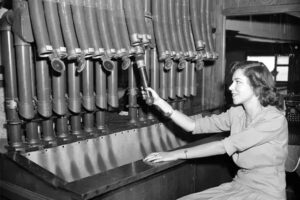The telegraphone is a historical communication device that marks an important milestone in the evolution of communication technology. Developed by Valdemar Poulsen in 1898, the telegraphone revolutionized the way audio recordings were made and played back. It played a crucial role in the early days of audio preservation and archiving, as well as in the development of magnetic tape recorders. Understanding the telegraphone’s significance in the history of communication is vital in appreciating the advancements that have shaped our modern world.
Table of Contents
History of the Telegraphone
The telegraphone, invented by Valdemar Poulsen in 1898, marked a significant advancement in the realm of communication. This historical device greatly improved upon previous recording technologies, revolutionizing the way people stored and transmitted audio. During World War I, the telegraphone found its use in the military, aiding in various communication purposes. However, despite its initial popularity, the telegraphone saw a decline in the 20th century as newer recording technologies emerged.
Poulsen’s invention of the telegraphone introduced a groundbreaking recording method. It was a significant improvement over earlier devices that were limited in their audio quality and storage capabilities. The telegraphone’s usage during World War I showcased its crucial role in military communications, enabling quick and efficient transmission of messages. This period marked the peak of its popularity.
As the 20th century progressed, the telegraphone began to face competition from alternative recording technologies, such as vinyl records and magnetic tapes. These new mediums offered increased convenience and higher fidelity audio reproduction. The telegraphone’s decline became evident as more advanced recording devices gained prominence, rendering it somewhat obsolete.
Despite its decline, the telegraphone holds an important place in the history of communication. It paved the way for subsequent recording technologies by introducing the concept of magnetic recording. This innovation laid the foundation for the development of magnetic tape recorders, which went on to revolutionize the audio industry. Even today, the influence of the telegraphone can still be seen in the various modern adaptations and attempts to revive this historical device.
Understanding the history of the telegraphone is crucial to appreciating the advancements made in communication throughout time. By acknowledging its significance and the improvements it brought about, we can better comprehend the evolution of recording technologies and the impact they have had on the way we communicate. The telegraphone may have faded into obscurity, but its legacy lives on, reminding us of the importance of understanding past technologies to fully grasp and appreciate the modern advancements we enjoy today.
How the Telegraphone Works
The telegraphone, invented by Valdemar Poulsen in 1898, revolutionized the way communication could be recorded and played back. At its core, the telegraphone utilized magnetic recording and playback principles, allowing for the storage and retrieval of sound.
Magnetic recording involves the conversion of sound waves into electrical signals, which are then encoded onto a magnetic wire. The wire is coated with a thin layer of magnetic material, such as iron oxide, that can retain the encoded signals. The recording process begins by passing the wire across a playback head, which consists of a small electromagnetic coil. As the wire moves past the playback head, the coil detects the magnetic signals and converts them back into electrical signals, which can then be amplified and played through a speaker.
The telegraphone’s mechanics were relatively simple yet ingenious. At the heart of the device was the magnetic wire, which was wound onto a spool. By turning a crank, the user could feed the wire across the playback head, allowing for recording or playback. The wire itself was thin and flexible, which made it easy to transport and store.
Compared to earlier recording devices like phonographs and cylinders, the telegraphone offered several advantages. Firstly, it could record and play back sound without the need for physical grooves or embossments, relying solely on the magnetic properties of the wire. This made it more durable and less susceptible to degradation over time. Additionally, the telegraphone allowed for multiple recordings on a single wire, enabling the user to overwrite previous recordings. This flexibility was particularly useful during World War I when the telegraphone was utilized for military purposes, such as transmitting confidential messages.
As recording technology advanced throughout the 20th century, the telegraphone gradually fell out of favor. More convenient and user-friendly options like vinyl records and magnetic tapes emerged, offering higher fidelity and easier access to recorded sound. During the digital revolution, the telegraphone became obsolete, replaced by digital audio formats and the widespread adoption of computers as recording and playback devices.
However, the legacy of the telegraphone cannot be overlooked. Its invention paved the way for subsequent recording technologies, including the development of magnetic tape recorders. Moreover, the telegraphone played a crucial role in audio preservation and archiving, as well as in early radio broadcasting and sound design. Despite no longer being a commercial success, there have been modern attempts to revive and adapt the telegraphone for artistic and experimental purposes, demonstrating its lasting influence on the history of communication.
In conclusion, the telegraphone stands as a muted echo of communication’s past, embodying the ingenuity and impact of early recording devices. Understanding its principles, mechanics, and differences from modern recording devices is essential in appreciating the strides made in communication technology. By exploring the telegraphone’s history and legacy, we can gain a deeper understanding of how far we have come and the continued advancements that shape our present and future.
Applications of the Telegraphone
The Telegraphone, a fascinating historical device, played a crucial role in several areas of communication. Its contribution to audio preservation and archiving cannot be overstated. With its invention by Valdemar Poulsen in 1898, the telegraphone revolutionized the recording industry by offering a more advanced solution compared to previous recording devices.
During its early years, the telegraphone found use in early radio broadcasting and sound design. Its ability to capture and reproduce sound opened up new avenues of creativity in these fields. From radio dramas to musical performances, the telegraphone facilitated the transmission of audio content to a wider audience.
Perhaps one of the most significant impacts of the telegraphone was its contribution to the development of magnetic tape recorders. The principles behind magnetic recording and playback, which the telegraphone relied on, paved the way for the subsequent advancements in recording technology. Magnetic tape recorders took the torch from the telegraphone and further transformed the way we record and playback sound.
The telegraphone’s application in audio preservation and archiving cannot be underestimated. Before the digital era, it served as a vital tool in preserving historical audio recordings. By capturing sound on magnetic wire, the telegraphone allowed for the storage and retrieval of valuable audio content, ensuring its longevity for future generations.
In conclusion, the telegraphone had a lasting impact on different areas of communication. From its role in audio preservation and archiving to its contributions in early radio broadcasting and the development of magnetic tape recorders, the telegraphone shaped the trajectory of sound recording technology. Understanding its significance in communication’s history is crucial in appreciating and valuing the advancements we have today.
Competitors and Successors
The telegraphone was a revolutionary device in its time, but it was not without its competitors. Similar recording technologies were being developed around the same period, offering alternatives to the telegraphone’s magnetic wire recording system. One notable competitor was the phonograph, invented by Thomas Edison in 1877. Unlike the telegraphone, which used magnetic principles for recording, the phonograph utilized a mechanical method, with grooves etched into a rotating cylinder.
Another significant competitor to the telegraphone was the rise of vinyl records and magnetic tapes. Vinyl records, which became popular in the mid-20th century, provided a more convenient and accessible way to record and listen to music. They were widely adopted by the music industry due to their superior sound quality and durability compared to the telegraphone’s magnetic wire.
However, it was the emergence of magnetic tape recorders that truly signaled the obsolescence of the telegraphone. In the mid-20th century, magnetic tape technology became widely available and revolutionized the recording industry. It allowed for longer recording times, higher fidelity, and greater ease of use. The telegraphone simply could not compete with these advancements and gradually faded into obscurity.
Ultimately, it was the digital revolution that sealed the fate of the telegraphone. With the advent of digital recording and storage technology, traditional analog recording devices like the telegraphone became obsolete. The digitization of sound not only offered higher quality and flexibility but also made it easier to store, share, and manipulate audio recordings. Today, digital recording is the standard and has completely transformed the way we communicate and consume media.
In conclusion, the telegraphone was a remarkable invention that played a significant role in the history of communication. However, it faced strong competition from rival recording technologies such as the phonograph, vinyl records, and magnetic tapes. The digital revolution ultimately rendered the telegraphone obsolete, paving the way for the modern technology we use today. Understanding the evolution of communication technology is crucial in appreciating the advancements we enjoy in the present day.
Legacy and Importance
The telegraphone holds a significant place in the history of communication as a device that marked a turning point in recording technologies. Its invention by Valdemar Poulsen in 1898 revolutionized the way audio could be captured and reproduced. This early magnetic recording device paved the way for subsequent technologies and had a lasting impact on the field of communication.
The telegraphone’s influence on subsequent recording technologies cannot be understated. Its magnetic recording and playback principles formed the basis for the development of magnetic tape recorders and other modern devices. By utilizing magnetic wire and a playback head, the telegraphone introduced a method that allowed for more accurate and efficient audio reproduction.
This groundbreaking technology found various applications in different fields. The telegraphone played a crucial role in audio preservation and archiving, ensuring that historical recordings could be properly documented and saved for future generations. It also had a significant impact on early radio broadcasting and sound design, enhancing the quality and variety of audio content that could be produced.
Despite its initial popularity, the telegraphone eventually faced competition from alternative recording technologies. Vinyl records and magnetic tapes emerged as formidable competitors, with their own unique advantages. The digitization of audio in the late 20th century further rendered the telegraphone obsolete. Nevertheless, the telegraphone’s contributions and significance cannot be overlooked.
In recent years, there have been attempts to revive and adapt the telegraphone for modern use. Artists and enthusiasts have experimented with this historical device, exploring its unique sound quality and incorporating it into contemporary music production. This resurgence demonstrates the enduring fascination with the telegraphone and the appreciation for its role in shaping the history of communication.
In conclusion, the telegraphone stands as a muted echo of communication’s past, leaving a lasting legacy in the history of audio recording and communication. Its influence on subsequent recording technologies and its applications in various fields highlight its importance in advancing the way we capture, preserve, and experience sound. Understanding and appreciating the telegraphone’s role in the development of communication technologies is essential in recognizing the significance of modern advancements in the field.
Conclusion
In conclusion, the telegraphone holds a significant place in the history of communication. This historical device, invented by Valdemar Poulsen in 1898, marked an important advancement in recording technology. The telegraphone allowed for the magnetic recording and playback of sound, revolutionizing the way information was stored and transmitted. Its importance during World War I for military purposes cannot be overstated, as it played a crucial role in secure communication.
The telegraphone’s popularity soared in the early 20th century, but then began to decline with the rise of vinyl records and magnetic tapes as alternative recording technologies. However, its impact on subsequent recording technologies cannot be underestimated. The telegraphone laid the foundation for the development of magnetic tape recorders, which went on to shape the audio industry for decades. Its influence on audio preservation and archiving, as well as its usage in early radio broadcasting and sound design, cannot be overlooked either.
Understanding past technologies like the telegraphone is essential in appreciating the modern advancements we enjoy today. By examining how communication devices have evolved over time, we can better grasp the challenges and triumphs of our predecessors. This comprehension allows us to not only appreciate the convenience and efficiency of our current communication systems but also recognize the efforts and ingenuity of those who came before us.
In conclusion, the telegraphone is a muted echo of communication’s past that echoes loudly its significance and impact. It stands as a testament to human ingenuity and our relentless pursuit of improved communication methods throughout history. By acknowledging and learning from the advancements of the past, we can continue to push the boundaries of communication and shape a more connected future.




